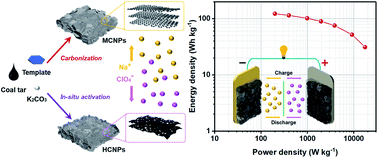Natural template derived porous carbon nanoplate architectures with tunable pore configuration for a full-carbon sodium-ion capacitor†
Abstract
Sodium-ion capacitors (SICs) combine the advantages of sodium-ion batteries and supercapacitors and have been regarded as one of the promising electrochemical energy storage devices. However, the electrochemical performance of SICs is still restricted by the mismatch between the cathode and the anode. In this work, we report a simple and low-cost synthesis method to fabricate three-dimensional carbon nanoplates as both anode and cathode materials for SICs by using coal tar as the carbon precursor and dolomite-derived hydroxide as the template. Mesoporous carbon nanoplates obtained by a templated carbonization process feature an interconnected nanoplate architecture with abundant meso-/macropores and enlarged carbon interlayer spacing, enabling the constructed anode to deliver superior sodium storage performance in terms of rate capability and long-term cycling stability. Hierarchical porous carbon nanoplates are prepared by simply introducing K2CO3 activation into the templated carbonization process, in which abundant micropores are created based on the nanoplate architecture, thus endowing excellent capacitive behavior for anions. As expected, the constructed full-carbon SIC exhibits high energy and power densities (122.4 W h kg−1 and 17.5 kW kg−1) as well as a long cycling lifespan (71% of the initial capacitance after 7000 cycles). This work may open an avenue for developing low-cost electrode materials of high-performance full-carbon SICs.



 Please wait while we load your content...
Please wait while we load your content...